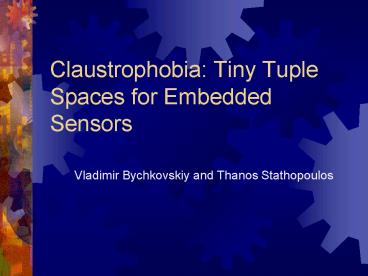Claustrophobia: Tiny Tuple Spaces for Embedded Sensors - PowerPoint PPT Presentation
1 / 10
Title:
Claustrophobia: Tiny Tuple Spaces for Embedded Sensors
Description:
Claustrophobia: Tiny Tuple Spaces for Embedded Sensors. Vladimir Bychkovskiy and ... How to program interactions for sensor network applications? ... – PowerPoint PPT presentation
Number of Views:122
Avg rating:3.0/5.0
Title: Claustrophobia: Tiny Tuple Spaces for Embedded Sensors
1
Claustrophobia Tiny Tuple Spaces for Embedded
Sensors
- Vladimir Bychkovskiy and Thanos Stathopoulos
2
Motivation
- How to program interactions for sensor network
applications? - message passing (traditional approach)
- pro flexibility gt energy
- con complexity gt development time
- Types of interactions
- reliable transport, routing
- voting, distributed mutual exclusion (scheduling)
- leader election (beamforming, tracking)
- many-to-many reliable communication (processing
and aggregation) - Goal
- develop a set of high level communication
primitives, based on Linda1, to augment message
passing
3
Related Work
- Why re-implement? Why not use JavaSpaces2!
- wireless communication
- long periods of link fading
- low bandwidth
- different failure modes
- failed node may never come back
- resource intensive
- Why not use Directed Diffusion3?
- very good for data collection (pull)
- unreliable one-way stream-based communication
- lack of consistency guarantees
- very hard to implement agreement protocols
4
Tuple Spaces in Sensor Networks
- Linda1
- pro agreement protocols are easy to implement
- cons
- requires reliable communication
- too communication intensive for general use
- provides more than we want to pay for
- a lot of communication gt high energy usage
- Adapted Linda
- pro
- agreement protocols are still easy to implement
- specifically designed for failure modes for
sensor networks - lower energy usage when only probabilistic
guarantees are required - cons under-the-hood complexity
5
The Demo Scheduling
- Scheduling and mutual exclusion
- Serialization of execution
- Demonstrates
- take()
- write()
- read()implicit in take()
if (ID INITIATOR) write(count,
1) while(1) take(count, ?cnt)
display(cnt) sleep() cnt write(count,
cnt)
6
Problems and Solutions
- Problems
- Low bandwidth, flaky connectivity
- Reliability is expensive in terms of energy
- Solution Replication of tuples on multiple nodes
- majority rule4
- Not necessary to get all replies when doing a
read() or write() operation - Only r w needed, s.t. r w gt N
- Corrolary cheap reads or writes
- Can be tuned to optimize energy consumption
- Reliable write() impossible?
- Even demanding that a write() needs to reach w
nodes is expensive - 2-phase commit does not work in the presence of
arbitrary link and node failures - Last ack problem
7
Proposed Solution read() and write()
- Assumptions
- packet loss
- Low level write()operation is best effort
- Single attempt, no guarantees just like
broadcast - Versioning
- Tuples have nodeId and sequence numbers
- read() needs the majority to agree on the value
- Tie-breaker if majority cant agree, pick value
with lowest nodeId and lowest sequence number - guarantees consistency
- Reliable write() is possible
- Keep writing and reading until the read() returns
the value written
8
Proposed solution take()
- take() a special write()
- more strict than read()
- majority must always be reached in order to make
a decision - request includes requesters nodeId and sequence
number - If tuple exists in local cache
- mark it as taken
- send it to the first requestor
- Notes
- taken tuple is not discarded from the cache
- subsequent requests from the same node will be
honored only if the sequence number matches (a
retransmission) - subsequent requests from other nodes will get a
NACK reply - At most once semantics
- Exactly once, if the write is successful
- Solution verify the write()!
9
Conclusions Future Work
- Conclusions
- An implementation of a Linda-like system is
feasible on very small sensor nodes. - Group communication is cheap within a single
broadcast domain most of the time. - Future work
- precisely evaluate energy requirements
- implement an energy-aware version of Linda
- use probabilistic responses to save energy
- explore fault-tolerance issues
- evaluate a possibility of tuple space over
multiple broadcast domains
10
References
- 1 "Generative communication in Linda", David
Gelernter, ACM Transactions on Programming
Languages and Systems(TOPLAS), January 1985,
Volume 7, Issue 1 - 2 JavaSpaces v1.1 Specification (JavaSpaces is
a trademark of Sun Microsystems.)
http//www.sun.com/jini/specs/js1_1.pdf - 3 "Directed diffusion a scalable and robust
communication paradigm for sensor networks",
Chalermek Intanagonwiwat and Ramesh Govindan and
Deborah Estrin. Proceedings of the sixth annual
international conference on Mobile computing and
networking, 2000,1-58113-197-6, p. 56-67, Boston,
Massachusetts, United States - 4 Weighted voting for replicated data, David
K. Gifford, Proceedings of the seventh symposium
on Operating systems principles (SOSP),
1979,0-89791-009-5, pp150-162, Pacific Grove,
California, United States































